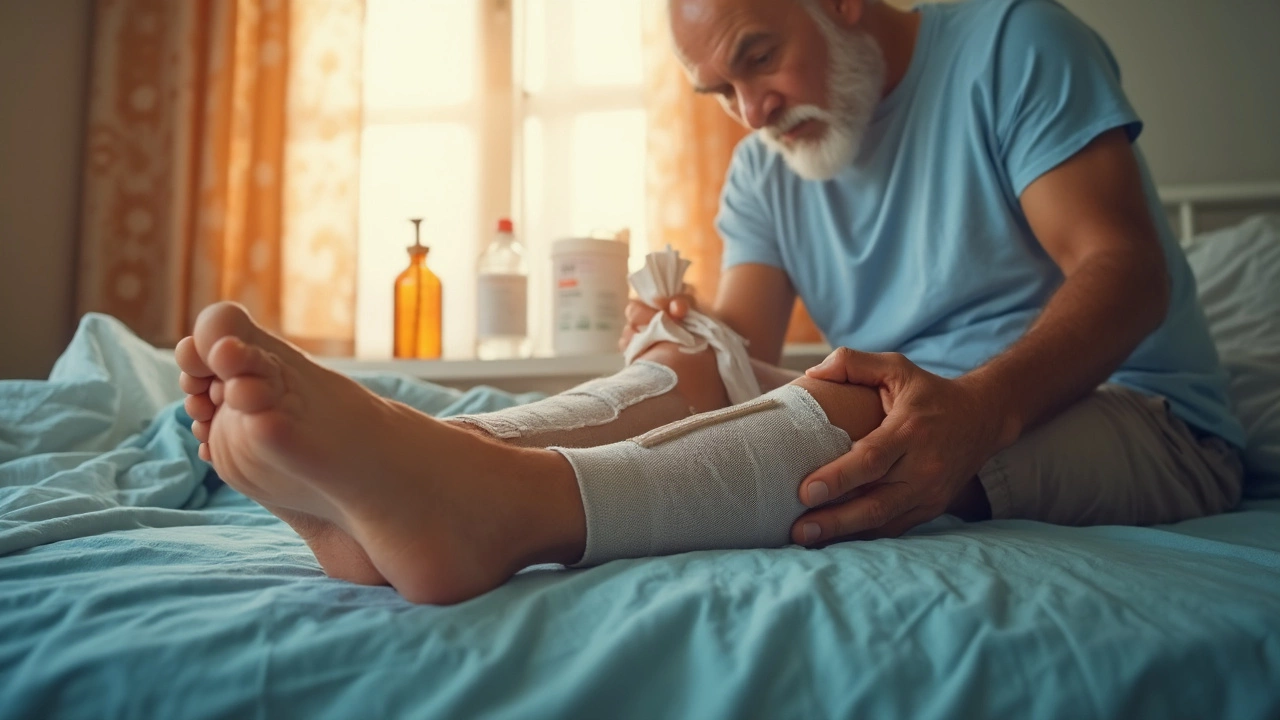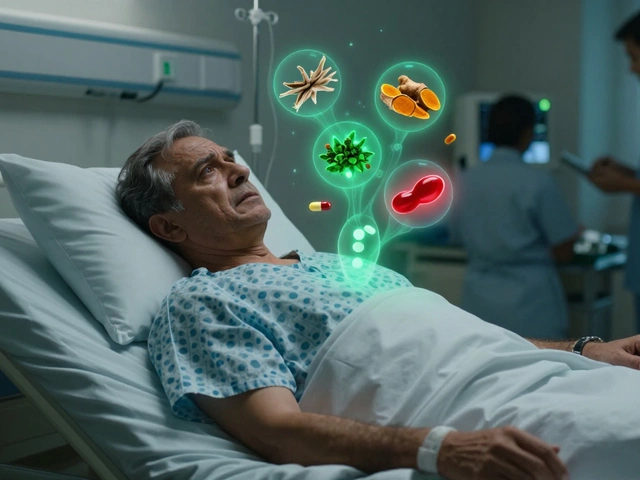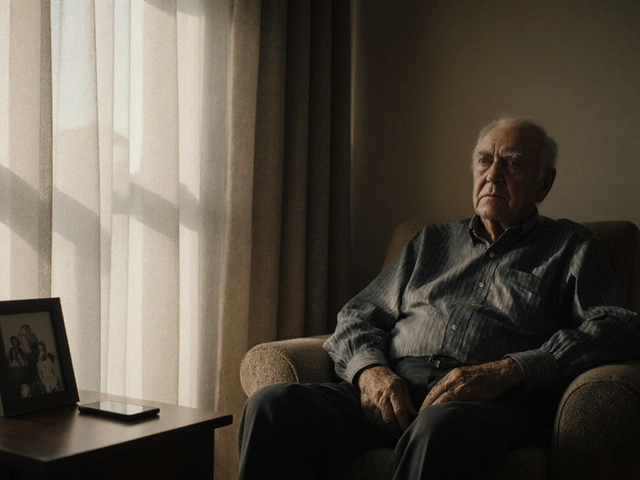Your knee’s been replaced, you’ve got stitches or staples, and you’re itching for a proper shower. So why do doctors hit pause on jumping under the spray? It’s all about the incision—your wound is fresh, and exposing it to water isn’t just risky, it can seriously mess with your recovery.
Water might seem harmless, but in the first stages after surgery, it’s a highway for germs. Hospitals go hard on infection control, but your bathroom, despite how clean you think it is, doesn’t stand a chance. Even letting water run over a healing cut can force bacteria inside, or mess up the scab that’s just starting to form.
Missing those showers feels rough, but there’s a good reason behind all the strict surgeon instructions. One quick slip-up, and you could end up with an angry, painful infection that drags out the whole healing process—or sends you back to the hospital. Nobody wants that, especially with a brand-new knee to protect.
- What Happens to Your Knee During Surgery
- Why Water Is a Big Deal for Fresh Incisions
- What Happens If You Ignore The Shower Rule
- How To Stay Clean Without Showering
- How Long Do You Really Have To Wait
- Smart Hacks and Helpful Products
What Happens to Your Knee During Surgery
Knee replacement isn’t just about swapping out a worn part like it’s a pair of sneakers. Here’s what really goes down in the OR. First, the surgeon moves the kneecap aside and cuts away damaged bone and cartilage from your thigh bone, shin bone, and sometimes the underside of your kneecap. The fresh surfaces get replaced with metal and plastic parts that are designed to mimic your natural joint, but without all the pain and grinding.
This is a big-deal operation. We’re talking about cutting, drilling, and a fair amount of force to get everything lined up just right. The surgeon usually closes up with stitches, staples, or glue, and then slaps on a waterproof dressing. That skin cut? It’s your incision—and it’s why showering after knee surgery gets put on hold right away.
Here’s a quick look at what’s involved:
- Surgeon opens the front of the knee, usually 6-8 inches long
- Removes the damaged cartilage and bone
- Fits and positions the new artificial parts
- Closes everything up with stitches/staples
- Covers with a sterile dressing
Your knee just went through a lot, which is why keeping the incision clean and dry is the first rule after surgery.
| Knee Replacement Fast Facts | Numbers |
|---|---|
| Average Incision Length | 6-8 inches |
| Surgery Time | 1-2 hours |
| Average Hospital Stay | 1-3 days |
| Full Incision Healing | About 2 weeks |
Why Water Is a Big Deal for Fresh Incisions
So here’s the deal: right after knee replacement surgery, the incision on your knee isn’t sealed up tight. Even with those fancy stitches and dressings, water can sneak in and carry bacteria right to the wound. That’s a shortcut to an infection nobody wants.
Hospitals are actually super strict about wound care because infections after knee surgery can be a huge setback. According to the American Academy of Orthopaedic Surgeons, surgical site infections can bump up your hospital stay by a week or more—and that’s if things don’t take a nasty turn. Nobody wants to go back for another round of surgery just because of some shower water.
Here’s a straight-up quote from Dr. Rajeev Pandarinath, an orthopedic surgeon:
"When water gets on a fresh post-surgical incision, it can turn even a clean-looking wound into an entryway for severe infections. It’s not about looking clean — it’s about keeping that bacteria out until the incision seals."
And get this: a study in 'The Journal of Arthroplasty' found that nearly 1 in 50 people who developed a wound infection after knee replacement needed another surgery just to clean things out. That's a wild risk for a rinse.
So, how does water make things riskier right after showering after knee surgery? Here’s a quick list:
- Water weakens or loosens the surgical dressing.
- It lets germs ride straight in through the incision.
- It can wash away the scab and slow down healing.
- A wet wound isn’t able to form that tight, protective seal your body needs.
Still curious about the numbers? Check this out:
| Risk Factor | Impact on Recovery |
|---|---|
| Early Shower (within 48 hrs) | 3x higher rate of wound infection |
| Secure Dry Dressing | Helps incision close 2-4 days faster |
| Wound Infection | Up to 14 more days in hospital |
Simply put: until your doctor clears you, water and wounds just don’t mix. Stick to their instructions, and you’re way more likely to heal up smooth and quick.
What Happens If You Ignore The Shower Rule
Alright, let’s get real—if you jump in the shower too soon after showering after knee surgery, you’re rolling the dice with your recovery. The number one problem is infection. When you get that fresh incision wet before it has sealed up, bacteria from water, your skin, or the shower surface itself can sneak right into your wound. Infections aren’t just inconvenient—they can turn serious, fast. A 2022 study out of the Mayo Clinic found that post-op knee infections can double your healing time and sometimes lead to another surgery.
Even if you don’t get a full-blown infection, there are other messy issues. If stitches or glue get soaked, they might loosen up or break open, causing the wound to split. That means your knee could open back up or start to ooze. Incisions that get wet too early also take longer to scab over, which just extends how long you’re stuck waiting to shower like a normal human.
Here’s what people risk when they bend the rules:
- Red, swollen, painful scars (and in some cases, permanent changes in how the wound heals)
- Yellow or green drainage from the wound—never a good sign
- Having to start oral or even IV antibiotics, sometimes for weeks
- Potential re-hospitalization if things get really ugly
- Risk of damage to the new knee hardware if infections reach the joint
Doctors see this all the time. Someone thinks, “I’ll be quick and careful!” Then they’re back in the office a week later, wound looking worse, maybe with a fever. It’s just not worth it for one shower.

How To Stay Clean Without Showering
Stuck without a real shower? No worries. Keeping clean after showering after knee surgery is off-limits is actually more doable than you’d think. The goal is fresh skin without getting your wound wet, and a ton of people have done this before you—successfully.
The MVP here is the classic sponge bath. Grab a washcloth, a bowl of warm water, and a bit of mild soap. Focus on one part of your body at a time, being extra careful to steer clear of your incision. No need to dunk yourself in water; just wipe, rinse with a clean cloth, and dry off afterward.
- Start with your face and neck, move to arms and underarms.
- Next, your torso and back. Then legs—just stay below the knee if the surgery spot is wrapped up.
- Last up: hands, feet, and those spots that get sweaty fast.
- If you sweat a lot or get oily, baby wipes (unscented, alcohol-free) do the job in a pinch.
Dry shampoo is a game changer for hair. Rub it in, brush it out, and you’ll look a bit less like you’ve been through surgery (even if you feel otherwise). No-rinse body wipes made for hospital use are another pro tip—super handy, especially if you’re afraid of losing balance in the bathroom.
Still feeling extra? Here’s a small cheat sheet for products people swear by after knee surgery:
| Product | What It Does |
|---|---|
| No-rinse cleanse wipes | Easily cleans skin without water |
| Dry shampoo | Makes oily hair easy to manage |
| Handheld shower head (with help) | Gives control if you need to clean below the knee only |
| Waterproof cast covers | Add extra protection if you have to use a wet cloth near your knee |
Keep in mind: your wound is off-limits for scrubbing or soaking until your surgeon says go. The rest of you can still feel human during recovery—it just takes a few tweaks to your normal bathroom routine.
How Long Do You Really Have To Wait
You probably just want a simple answer, right? For showering after knee surgery, most surgeons say you’ve got to wait at least 10 to 14 days. This isn’t just some random number—your incision needs to seal up tight before water hits it. If you’ve got stitches, glue, or staples holding things together, water can undo the healing work behind the scenes.
Doctors look for two main things before giving you the green light:
- The wound is totally closed—no gaps, no scabs falling off, no oozing.
- There are no signs of infection like redness, swelling, or weird drainage.
Here’s how the timeline usually looks after knee replacement:
| Days After Surgery | Showering Status | What Most Doctors Say |
|---|---|---|
| 0-3 days | Absolutely No | Keep incision bone dry. Use washcloths. |
| 4-10 days | Still No | Sponge baths only. Don’t soak or let water near the dressing. |
| 11-14 days | Maybe | If you got dissolvable stitches/glue and incision is closed, quick showers might be okay—ask your doc. |
| 15+ days | Usually Yes | If no redness, swelling, or drainage, and scab is gone, most doctors are fine with showering. Still avoid soaking in tubs or pools. |
Pay attention to your doctor’s advice and your own healing. Sometimes, folks need to wait a full 3 weeks if the cut heals slow. And here’s a tip—you definitely shouldn’t try to cover the wound on your own with tape or kitchen plastic and hope for the best. Waterproof wound covers are made for this, but even then, you need your doctor’s green light first.
Last thing—when you do shower, it’s for cleaning, not relaxing. Get in, get clean, get out. No lingering. If you notice weird redness or gunk after, call the doctor. Don’t play the tough guy with your new knee.
Smart Hacks and Helpful Products
Just because you have to skip the shower doesn’t mean you need to feel gross or frustrated. There are simple, tried-and-true shortcuts to staying clean and comfortable after knee surgery. Let’s get into the real-life hacks and gear people use to get by.
If you're worried about cleaning up without water, start with good old-fashioned sponge baths. Grab a pack of fragrance-free baby wipes for quick wipes down — most hospitals even hand these out for those first messy post-surgery days. Choose wipes without alcohol because they won't dry out your skin. Dry shampoo is a total lifesaver for greasy hair, especially if you get the spray kind. For your face, micellar water on a soft cotton pad gets rid of oil and sweat.
But what about that feeling of wanting a legit shower? Here’s where waterproof cast and bandage covers come in. These covers have tight seals and are cheap on sites like Amazon. They’re way better than trying to wrap your knee with plastic bags and tape. According to the American Academy of Orthopaedic Surgeons, "specialized waterproof protectors are designed to keep wounds dry and can help prevent infection caused by moisture.”
"Most people find that a removable, waterproof knee cover gives peace of mind and allows for a little more normalcy during recovery,” says Dr. Lauren D. Hill, orthopedic surgeon at Mount Sinai.
When shopping for a knee cover, look for these:
- Seals tightly above and below your bandage—no gaps or loose spots
- Reusable and easy to wash out for multiple uses
- BPA-free plastic or medical-grade silicone feels less sticky
If your clinic okays it, a handheld showerhead lets you aim water away from your wound, just be careful not to get the incision wet. And keep a sturdy chair or shower bench handy. Standing on one leg in a slippery tub is not the time to show off your balance.
Keep all bandages and covers close by the shower, and set everything up before you undress. That way, you won't have to shuffle awkwardly around your bathroom with a bare knee.
Follow your surgeon’s timeline for when full showers are safe. If you have any redness, pus, or new pain at the wound, skip the hacks and call your doctor right away. Infection is no joke. Give yourself a break and use these showering after knee surgery tips until you get the green light.






